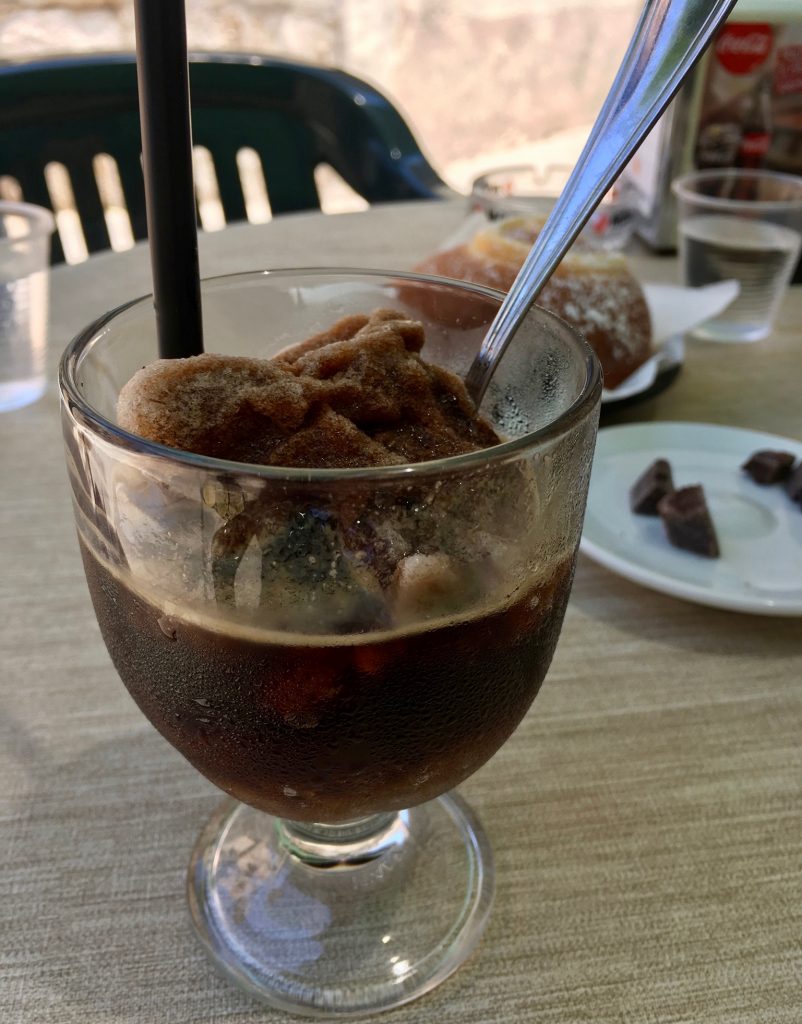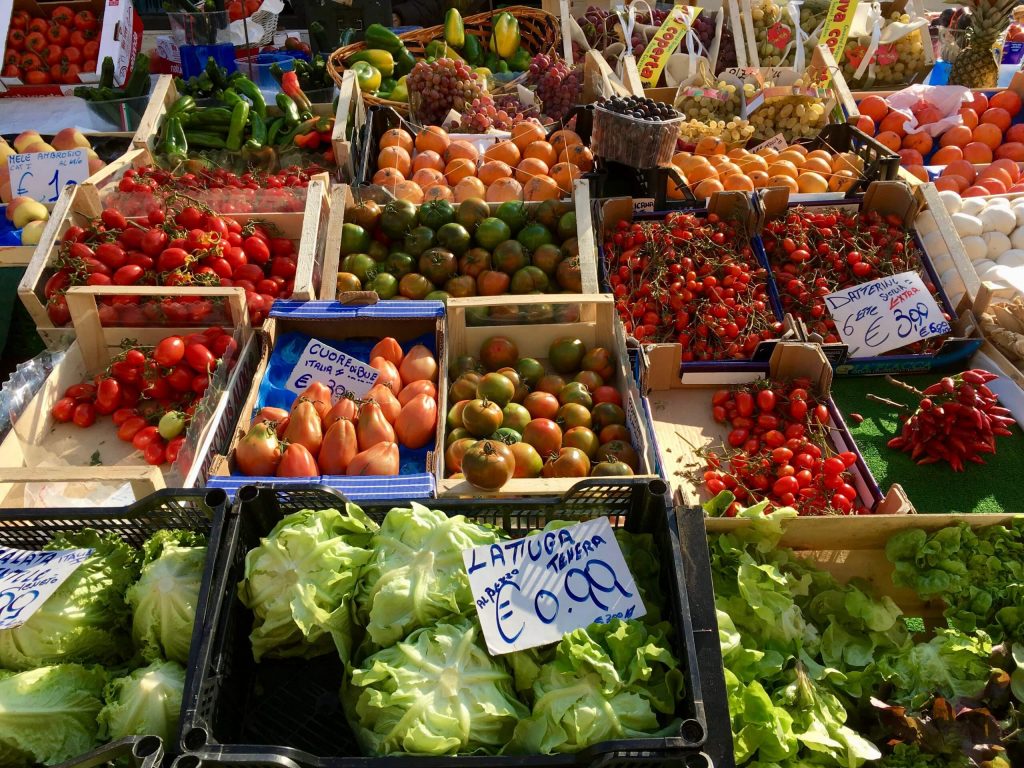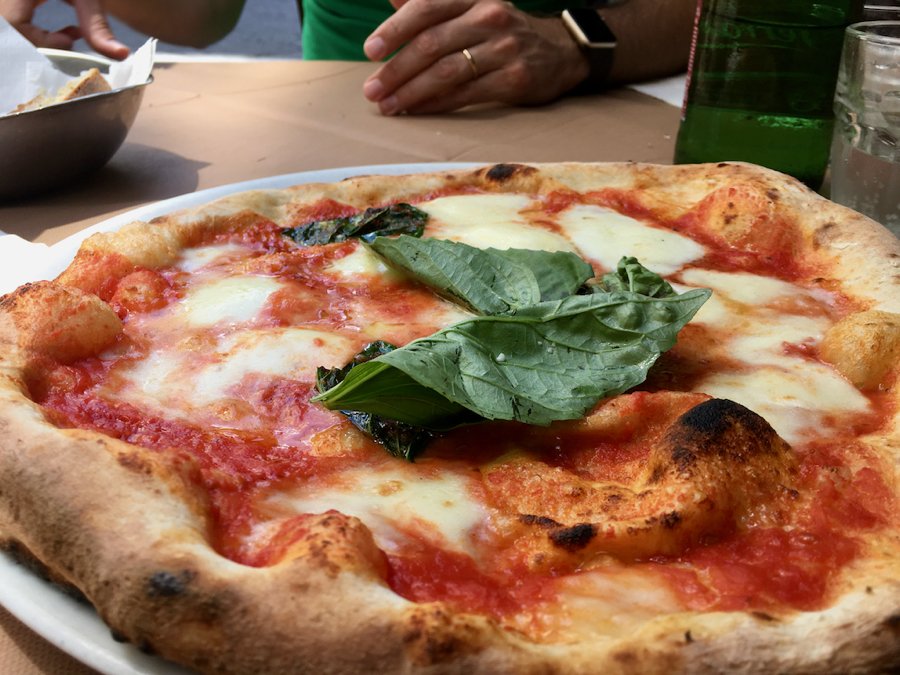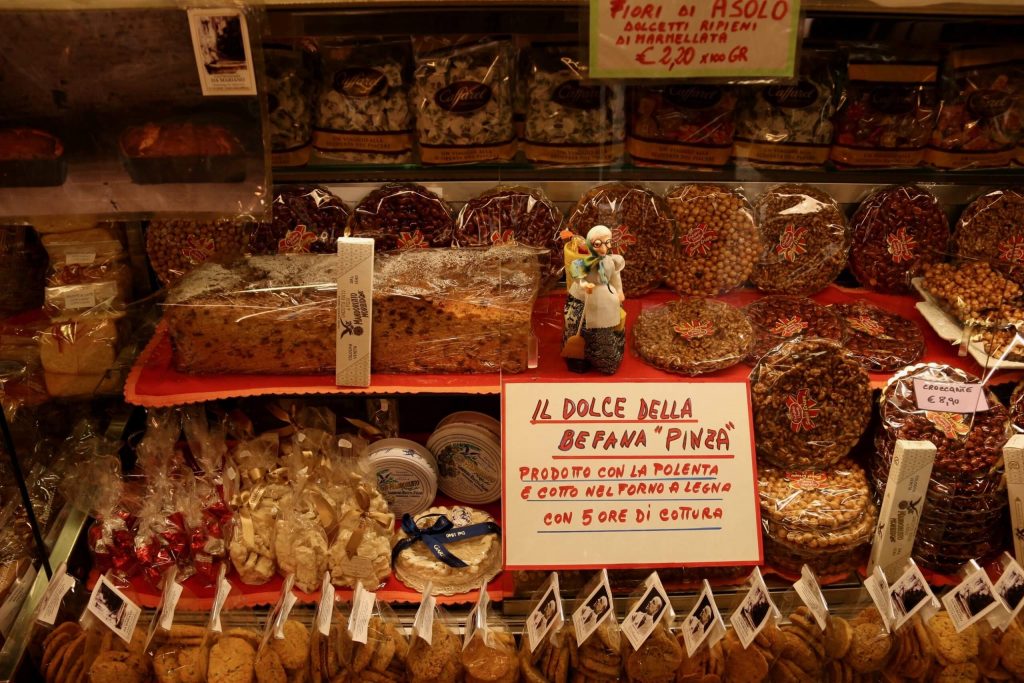How Italians Stay Thin Eating Pizza & Pasta All the Time
After living in Italy for three years, this is the best thing I learned: How Italians actually eat, and how they enjoy food and stay thin at the same time. These 13 ideas go way beyond “the Mediterranean diet.”
If you look at a menu in Italy, it seems like everything is carbs cooked in oil or heavy cream, then covered in cheese, with a side of cured meat. (Or at least those are the dishes that jump out at you.) Then you look around at the people in the restaurant, and you wonder: How do Italians stay so thin?
Why aren’t more Italians overweight, when they’re always eating pizza and pasta? And wine and dessert.
That’s the question I get all the time from Americans who’ve been to Italy, and from other Europeans, too. And with good reason!
The way Italians eat basically goes against everything we learn about food in the US – and the results are the opposite too.
The answer is more straightforward than I expected before I lived in Italy, but it’s definitely not as simple as “the Mediterranean diet,” either.
We think of the Mediterranean diet as one singular thing: Fresh fruit, vegetables, olive oil, fish, nuts and wine. Not so much meat or cheese. No processed foods. Some parts of that are accurate, but it really isn’t how most people eat in Italy, either.
And of course, calling anything a “Mediterranean” diet is a major oversimplification of the way people eat in the diverse countries around the Mediterranean. From my experience, in Greece people eat tons of red meat. In Italy there’s a lot of cheese, and in France lots of cheese and butter.

Even going up and down Italy, you’ll find wild variations in the cuisine from one region to the next, and different specialties from one town to the next. (This is one of my absolute favorite things about traveling in Italy.)
Some general differences: The South has much more fried and spicy food and (historically) more fresh olive oil. The North, especially up in the Alps, has more butter and dishes that are covered in melted cheese (and also, now, lots of fresh olive oil).
But there are several things that tie together the Italian way of eating, and they’re really different from how we’re taught to eat in the US.
There’s something on this list for everyone – from meat and beer, to snacks and vacations!
1. Italians Eat Food – Not Nutrients
You know how if you order a salad in the US, the server will probably ask if you want to “add some protein” to it? (Usually in the form of beef, chicken, salmon or tofu.) Italians don’t think of food this way, breaking it down to scientific components.
For the most part, people in Italy eat foods that have evolved over centuries for nutrition and taste. They probably started as recipes based on what was available and people’s tastes evolved with the dishes.
For example, fresh mozzarella, fresh tomatoes and extra virgin olive oil (a caprese salad) are a classic light lunch in Italy, maybe with some bread and/or greens. But Italians don’t order this thinking in terms like protein + vegetable + omega 3s + carbs for energy, etc. They eat it because it’s what they grew up eating and it tastes good.
Food is food in Italy, not macronutrients.
And Italian food culture is really strong and really traditional, which means people don’t have to think so hard about what to eat. It’s programmed from birth by mothers and grandmothers.
2. Breakfast is Light… But Sweet
Italians eat a sweet breakfast that feels almost decadent by American standards. It’s pleasurable, but still pretty low-calorie compared with a breakfast sandwich, or a plate of eggs, bacon and hash browns.
But it’s not like Italians eat a “diet” breakfast, either. Breakfast is always sweet – not light or low-fat – but it just isn’t a large meal.
Eggs are an ingredient in Italy, not a meal. There’s no meat at breakfast (ever) and no omelets, oatmeal, pancakes or waffles. (When you see those offered at hotels, they’re for North American and British tourists. The cold cuts, hard boiled eggs, and cucumbers on the breakfast buffet are for Northern Europeans.)
Italian breakfast options are actually really limited:
Breakfast at a bar (which is like a coffeeshop, but often also offers lots of other services) is coffee and a pastry. The coffee is either a cappuccino (about 6 ounces, max), or an espresso – with or without a dollop of milk foam (an espresso macchiato).
A bar might have non-dairy milk, but don’t even bother asking for skim. (For years, I only ever found soy milk, but since around 2023, I’ve been finding a lot more bars offering oat milk, too! It seems to get more common every time I go back.)
The most common pastry is something like a French croissant – called a brioche in the North, and a cornetto in Central and Southern Italy. But it’s often filled with chocolate, jam, cream, pistachio cream… the list of possibilities goes on. (While the French are 100% against filling croissants with anything but air and butter.)
Other options might be a narrow slice of cake (unfrosted), or a crostata – a tart made with jam or fruit.
Except in Sicily, where people slurp fresh granita (a frozen slushy-type treat) flavored with coffee or with local lemons, berries, pistachio or almonds for breakfast. It feels like eating ice cream for breakfast, because Sicily is heaven.


At home, Italian breakfast is coffee with a few plain, dry, hard cookies. I know – that’s not a very appetizing description. But you won’t find oatmeal or chocolate chips or jam or coconut or nuts in Italian cookies, at least not the breakfast ones. (Actually, you don’t find oatmeal of any kind, ever, in Italy.) No frosting or sprinkles, either.
When I first moved to Milan, I saw nothing to like in these cookies. But they grew on me. They’re plain and simple, but light and crumbly and perfect for soaking up coffee.
If you’re thinking, but how do they get enough protein? then don’t worry about it. That’s not a very Italian way to think.
3. Italians Eat One Food at a Time
I wrote a whole post about the art and structure of Italian meals, but this is the main idea: One food per plate, and one plate at a time.
If the most stereotypical, 1950s, home-cooked American meal is mashed potatoes, peas and meatloaf, you’d expect to find them all on the same plate. This is a foreign concept in Italy.
Even at home-cooked meals in Italy, you generally eat a first course (pasta, risotto or something carb-based) then clear away the plates. Then a second course (meat or fish) and a contorno, a vegetable side dish, which is served either with the second course or after – but not on the same plate.

I don’t know if this has been confirmed by science, but I think this orderly way of eating makes people eat less of each food.
Here’s why: When you have everything together, you continually change the flavor in your mouth, and never get sick of eating. But when you eat one food at a time, you either get satisfied by the flavor or you just realize more quickly that you’ve eaten enough, and end up eating less in total.
This is just my theory, but I think it makes sense, no?
Be warned, though, that this can totally backfire – which happened to me more than once when I first moved to Italy. Like when you’re at a dinner party and don’t know what to expect, so you eat too much of one course because you didn’t realize how many more were coming up. Lesson learned: It’s okay to ask.
4. Italians Don’t Snack
Snacking just isn’t done – except for little kids, of course. There are several reasons for this.
Meals are sacred in Italy. People make plans to sit down and eat with other people, they don’t just eat whenever they’re hungry (and then end up eating again when they meet up with people).
So you don’t grab a sandwich in the middle of the afternoon if you’re hungry. You generally just deal with being hungry until it’s dinner time. (Or aperitivo time.)

But I don’t think this is because Italians are all righteous and full of self-control. It’s because there’s a strong cultural taboo against eating outside of meal times. They feel like they really shouldn’t do it, even if maybe they’d like to.
Plus, meal times are really specific and inflexible. Lunch is 1pm to 2pm for basically everyone in Milan. Dinner is usually not before 8pm.
And when Italians do snack, it’s much more likely to be a piece of fruit or a couple of crackers than a bag of chips or candy. What are most snack foods in the US? Processed foods.
5. Italians Eat Fewer Processed Foods
Sure, this is changing a bit, as the whole world is changing. No culture remains the same forever, and Italy is starting to see more corporate influence from both foreign and Italian snack food and fast food brands. (Including Starbucks, which I wrote about when the very first Starbucks in Italy opened in Milan in 2019.)
There’s also more and more fast food available in Italy, and some people are starting to have those sedentary lifestyles centered around a computer with no exercise. These are definitely not good things but they’re still the exception, not the rule.
When you go to the grocery store in Italy, the selection of snack foods and candies available is just nothing like in the US. These foods are a much smaller part of people’s daily habits.
6. There Are No “Beverages”
Italians very rarely have drinks besides water between meals. (I’m afraid point #4 about not snacking throughout the day includes lattes.)
You just don’t see people walking down the street with a soda, a coffee cup, a milk tea or a smoothie. And a coffee break at work is a simple espresso (or a macchiato with a tablespoon of milk) down at the coffee bar, not a big sugary beverage that comes back to the desk.
But this goes beyond drinks between meals.
I’ve written before about how people will look at you funny if you order a cappuccino with savory food. Well, not only do Italians not drink coffee with food (except at breakfast) but they don’t drink almost any beverages with meals, except beer and wine. There’s no smoothie, milk, juice with lunch and definitely not with dinner. One exception is a small Coke for kids, or for adults who aren’t drinking beer or wine. (And it’s mostly as a way to not be left out.)

The drink of choice is usually sparkling or still mineral water, with no ice. Ever.
(It’s tough to get a glass of plain tap water in Italy. You often have to buy a bottle, although restaurants often use glass bottles, which are sometimes refilled over and over again at the source. You can tell by the horizontal ring of scratch marks at the shoulder of the bottle, from where it’s rubbed repeatedly against other bottles.)
Eliminating drinks with meals cuts a bunch of calories – but that’s usually not why Italians do it. They do it because they don’t want flavors competing with the delicious food they’re eating. The calories are just a bonus.
7. … And Way Less Beer
Italians don’t drink more than two beers in one casual setting. There are always exceptions (I have one friend in Italy who’s an exception) and, like everywhere else I’ve been in the world, clubs are a different story.
But I realized this when I first moved to Milan and went over to a friend’s house for a casual aperitivo gathering. I popped open a beer and started drinking from the bottle, then I realized what everyone else was doing: Opening a bottle, pouring a quarter of it into a glass, and putting the rest back on the table for someone else.
Sure, they might drink several of these servings, but no one in the States would think of sharing a 12-ounce light beer any more than an Italian would think of sharing an espresso.
And it’s not because Italians make up for beer by drinking way more wine. They don’t. Heavy drinking just isn’t part of Italian culture.
A note for the Europeans reading this: In Chicago, where I’m based now, it’s not uncommon for people (mostly men) to go out for three or four pints after work. Maybe they even get to half a dozen if they stay out for dinner. (I’m quite a beer aficionado myself, which became clear to me when I was living in China, but not to that degree.)
8. The Food System is Built on Seasonality, Freshness & Quality
Interest is growing in seasonal, local, and fresh foods in the US, but our food system as a whole doesn’t prioritize those things, and people expect to eat the same foods year-around.
The idea of restaurants serving a menu that changes with what’s in season is pretty new in the US. But it’s very standard in Italy. What’s more, I think people in Italy are educated from birth to recognize quality – and complain about bad quality.
For more about this fascinating topic, I cannot recommend highly enough Michael Pollan’s book The Omnivore’s Dilemma. (That’s an Amazon affiliate link, or you can also buy it from Bookshop.org. And there are many more book recommendations at the end of this article!)
I love all of Pollan’s writing, and this is one of the first books that got me interested in food. It covers how the US food system works, and explores what ideas like organic, local, and plant-based actually mean, in a way that’s both rigorously researched and totally entertaining.

9. People Cook Really Simple Food at Home
There are two parts to this:
- People cook at home, and
- Lots of Italian recipes are really simple, which is probably part of the reason people cook at home.
Of course not everyone in the country knows how to cook, or bothers. But when Italians do cook at home, it’s often from scratch – but it’s not that complicated! A lot of Italian dishes are really simple and don’t require the oven, a chunk of meat or multiple spices.
My favorite meals that we cook at home are easy, vegetable-heavy and meat-free. (Like this four-ingredient recipe for pasta with lentils!)
A pasta sauce is often just a few ingredients: Salt, water (do those even count as ingredients?), olive oil, garlic and/or onion, one spice or herb, and a vegetable. The vegetable could be anything – maybe tomatoes, broccoli, or zucchini – but not all at the same time.
If you know what you’re doing, that’s all it takes to make a delicious sauce out of exclusively fresh ingredients. No meat needed. And if you skip the dusting of freshly grated cheese on top, it’s even vegan.
[Related: If you’re looking for an easy way to eat more fresh fruit and vegetables at home, I reviewed a delivery service that’s been surprisingly great!]
10. Italian Cuisine Uses Meat For Flavor
Often dishes with meat use just a very small amount to add flavor, not as the focus of the dish. When I say small, I mean like one ounce of cured pork (like guanciale or pancetta) in a serving of pasta.
Yes, there are exceptions. Italy has lots of famous meat dishes, like Tuscany’s Bistecca alla Fiorentina – a cut of steak that can be four inches thick. Or Milan’s Cotoletta alla Milanese – basically chicken-fried veal.
But those specific dishes are more like special treats. They’re definitely not what people eat every day.
I’ve said for years that Italian cuisine is mostly carbs covered in cheese…
And it’s true, but I also think Italy is the easiest place in the world to avoid eating meat, and avoid most dairy if you want to. (The couple ounces of milk in a cappuccino are probably the hardest to avoid, as not all bars offer an alternative.)
Whereas in many European countries, most items on most menus include meat. In Italy, it’s much more balanced.
And the meat-free items are just as traditional as everything else – not tokens options for vegetarians.
There are even plentiful pizzas without cheese. But when a meal is carbs covered in cheese, another thing is different:
11. Portions Are Way Smaller
Portions in Italy are not what I would call small. But one thing I realized when we moved to Chicago is that my Italian husband and I can share almost any restaurant meal. This is not the case in Italy. It’s a whole different scale, and US portions are simply way bigger.
Yes, it’s true that everyone eats their own entire pizza in Italy – but everything about that pizza is completely different.
Napoli’s original pizza has a soft but very thin crust, cooked by a real fire on dry brick or stone – so no grease in the pan. The central flavor, the base of the pizza, is either fresh tomatoes or olive oil and garlic (which is called pizza bianca, or white pizza). On top of that are just two or three toppings – not six or eight. If it has meat, it’s almost certainly one kind and not very much of it. If it has cheese, it’s scattered out in a few spots on top – not smothering the entire pizza.


12. Not Every Meal is Big
After a small breakfast, no oversized coffee + milk + sugar beverage, a reasonable lunch, and no snacks all day… yeah, dinner might be several courses.
But dinner isn’t always a big meal. And when it is, it’s the only meal of the day that’s big.
One exception to this is Christmas, when all bets are off.
And by Christmas, I mean the period from early December through January 6th. Meals during the holidays in Italy can become frequent, outrageous, never-ending feasts that are almost too much to even be enjoyable.
This past Christmas was my second one in Italy, and one day I watched an episode of an Italian talk show about food. One of the guests said something brilliant about stressing over holiday weight gain:
“You don’t gain weight between Christmas and New Year’s, you gain weight between New Year’s and Christmas.”
I love this philosophy, and I feel like it’s followed pretty well in Italy. Allow yourself to indulge without feeling bad about it – but make sure indulgence is the exception, not the rule.

13. La Dolce Vita: More Vacations & Less Stress
There are a lot of differences between life in Italy and life in the US around stress, cash flow, and simplicity versus opportunity. That’s a topic for another post.
But I will say that I’ve experienced first-hand how much less stressful life is in Italy. (Even after the honeymoon effect wore off, and while I was unemployed, learning the language from scratch, going through the immigration process, and eventually keeping busy in grad school.)
Italians spend a lot more time on vacation than Americans. And a lot of things are simpler in Italy. The paychecks are nothing to write home about, and if you compare an Italian salary to a US one for the same job, it would sound like a poverty wage, but people don’t have to worry about health insurance or saving for retirement on their own. Fresh, local food is far less expensive, and families often live closer together and see each other more often.
If you’re still stressed after all that, hardly a month goes by without at least one long weekend. (Plus almost everyone takes at least a couple of weeks off both at Christmas and in August – without feeling guilty about it.)
This stuff adds up, and there are tons of studies about the effect of stress hormones on body weight. Being less stressed helps people focus on what’s important in life – like taking time to relax and enjoying good food.
More Great, Semi-Italian Food Writing:
In addition to The Omnivore’s Dilemma, which I mentioned in #8, here are a few more books about food that I love, and find really relevant to the topic of how Italians eat in Italy. They’re not all about Italy specifically, but they really resonate with the ideas in this post.
(The first links are for Amazon; the second ones are for Bookshop – my favorite small-business alternative. Both are affiliate links, so if you buy anything through them, I may earn a commission at no additional cost to you.)
- Heat, by Bill Buford. The story of an American magazine editor who moves to Italy to learn the secrets of Italian food. It’s hilarious and full of Italian culture and history, too! (On Bookshop here.)
- In Defense of Food, by Michael Pollan. If The Omnivore’s Dilemma is Pollan’s all-around look at the food industry, this is more of a deep-dive into the more nutritional side. (On Bookshop here.)
- Food Rules, also by Michael Pollan. I told you I love everything he writes! This is like a bullet-point version of In Defense of Food – most of the chapters are less than a page. It’s a very simple yet brilliant set of ideas for how to eat more healthily. (On Bookshop here.)
- Gumbo Tales: Finding My Place at the New Orleans Table, by Sara Roahen. An entertaining, inside look at New Orleans cuisine – including its Italian influences, which also highlights the differences between Italian and Italian-American food. (On Bookshop here.)
Do you have questions about Italian food culture that I didn’t answer? Let me know in the comments below!









This is so informative and wonderful. Great read.
Thank you.
Joyce O’Hara
Thank you, Joyce! I’m glad you enjoyed it. 🙂
Ketti
I love how you broke this out; what a great piece! Traveling Europe, I’ve had similar thoughts/conversations about people’s physical differences in relation to their diet and you’re spot on.
Thanks, Greg, glad you enjoyed it! I agree, I do think it’s fascinating how it’s a whole different way of eating and thinking about food in many places, especially in Western Europe.
-Ketti
As article, but with some inaccuracies (cotoletta alla milanese is not with chicken meat but with by far more precious veal).
And about the stress and life style: From what you wrote it seems we in Italy have so much holiday and free time, with job and working time in the background. This is not true, we have to (and love) to work hard like in any other place, the real difference is the approach we have with life.
Ciao Tortellino,
Thanks for your comment! Let me clarify:
In the US, we have a famous dish called “chicken-fried steak,” which is also not made with chicken. It’s steak. “Chicken-fried” is a style or method of pan-frying something. (While fried chicken is, of course, chicken. 🙂 ) That’s why in the article I called Cotoletta alla Milanese “chicken-friend veal.”
As for vacation, it’s all a matter of perspective.
I lived in the working city of Milan for three years, so I definitely do know how much Italians can also work, and I certainly didn’t say (or mean to imply) otherwise. But in the US, most people take 2 weeks or less of vacation every year. So compare that with Italy’s average 5 weeks of vacation (not counting the many long weekends for saints’ days and other things) and yeah, it’s a little different.
Thanks for reading!
-Ketti
Deaf Ketty, thank you for the clear explanation. I get the point better now. I found out your blog nowadays and let me say it’s really good.
Grazie Tortellino! That’s very good to hear. Thanks for checking out the blog more – and feel free to subscribe if you want to keep in touch! I’ll always be writing more about Italy. 🙂
-Ketti
Love it! I’ve always wondered this, and when I was in Italy for a week, I definitely “went for it” with food – trying to eat everything and anything. It’s cool to see an accurate depiction of life. Side note, the Margherita pizza I had from Naples was hands down the best pizza of my life
Thanks Kara! Yeah, I’ve definitely had a similar Naples experience… or several of them. 🙂
-Ketti
This article is basically flawless.
Grazie Andrea! I’m glad you enjoyed it. 🙂
-Ketti
This was really well-written and I unequivocally agree. (un’ americana a Roma)
Would love to connect with you on IG: @everflymsq
Grazie, Ms Q! Glad to hear it. I followed you back on ig. 🙂
-Ketti
Ciao Ketti. it’s a fun to know how foreign eyes see us. And I’m glad that Italy is still a source of curiosity (It makes me feel special like our food). Thank you and congratulation
Grazie Francesca. Italy will probably always be a source of curiosity for me. 🙂
That’s true. Japanese and Chinese food have similar concepts as Italian and French cuisine.
That’s true! Any place with a strong, historical food culture will have some of these similarities.
Ketti
Grazie per questo articolo. Sto imparando tutta d’Italia e le gente e la cultura. Questo articolo è molto interessante
Ciao Joshua, ma prego! Mi fa piacere se quello che scrivo può essere d’aiuto. Se hai delle domande, o altri temi che vorresti leggere per favore fammi sapere! 🙂
Ketti
And could it be that pasta isn’t actually fattening?
“We have seen that consumption of pasta, contrary to what many think, is not associated with an increase in body weight,” lead author of the paper, George Pounis, explained in a press release. “On the contrary: Our data show that eating pasta contributes to a healthier body mass index, lower waist circumference and better waist-hip ratio.”
– https://www.today.com/health/don-t-skip-spaghetti-new-study-says-pasta-not-fattening-t100515
Absolutely! But just taking that headline as advice and adding it to the average American diet isn’t going to slim anyone down. That’s why I explained all the other factors of the Italian diet that, together with perfectly healthy pasta, add up to such a beautiful thing. 🙂
Thanks for reading and keep in touch!
Cheers,
Ketti
I cook Italian but can’t imagine washing separate dishes for each course, even for 2 people!!! There was some snacking going on in Roma back when I lived there for a year (a life time ago, 1968-69). We often bought pizza al taglio which was priced by weight (per etto) usually around late morning – Romans usually ate this around 11am as a holdover till pranzo. There was also gelato from the street vendors which was irresistible in late afternoon. I’d love to go back sometime!
That’s a good point, gelato is the perfect exception to everything! And I bet the Romans eating pizza al taglio were a lot more active than people are today. I would have loved to have seen Rome back then. (Or back in pretty much any other time.)
As for the plates, at home people do sometimes use the same plate for multiple things, but they’ll eat what on it before reusing it for the next course/dish. At least that’s been my experience.
Thanks for commenting, Frank, and keep in touch!
Cheers!
Ketti
Really enjoyed reading this! Lived in Milan myself for a while and this blog couldn’t be more accurate<3
Thanks, John, that’s great to hear! 🙂
Ketti
Hi, I was just wondering whether you are able to make a post about how to start eating healthier like the Italian diet you have written?
I’m interested in enjoying my food more and not having to think about what I’m eating, and I’m interested in trying this food lifestyle.
Thanks, I’ve very much enjoyed this article!
Hi Chelsie,
Thank you so much! I’m glad you enjoyed the article, that’s great to hear. And that’s a really good idea for a future blog post! I’ll definitely keep it in mind. (And if you want to keep in touch so you don’t miss any new posts along those lines, I invite you to sign up for my email list! I send new blog posts out that way about twice a month.)
And while they’re not really a how-to guide, I do have a few recipes on the blog (from my husband’s family in Italy) that definitely embody that Italian way of eating that you’re looking for. Hope that helps, and keep in touch! 🙂
Ketti
Our Pizzamat has become a coveted choice for anyone who wants to enjoy a delicious pizza without having to wait long for service or a tip. Our data shows that an average location can generate up to 50 pizza sales per day. Demand can be even higher in particularly busy locations such as streets, schools, offices, hotels, clubs and side streets
☝️☝️☝️ THIS is exactly the kind of food I’m talking about that Italians avoid. 😂 (See #4, #5, and #8.)
Really, the answer is less disposable income, which you kind of touched on.
It means they eat less. Both in volume and frequency.
I don’t care how stress free your life is. Eat enough calories (especially carbs) and you’re going to put on weight.
One could have a diet of nothing but candy and not get fat, as long as you couldn’t afford to buy much candy.
The higher rates of smoking helps as well. Show me a country that has e-cigarette machines on street corners, and I’ll show you a country that probably doesn’t have much of an appetite.
Yes, of course, good health comes from poverty, and a diet of candy and cigarettes. That’ll be my next article. 😂
To be fair, your article title is about being “thin,” not necessarily healthy. The two can be mutually exclusive.
It’s probably why, while Italians aren’t fat, they also aren’t well built either. If you see a dude that looks like he benches, or a woman that looks like she squats, and it’s usually an American or Germanic person. Rarely is it an Italian.
An interesting question would be why is the current young generation of Italy suffering from such a high obesity rate compared to the rest of Europe?
My suspicion is they are the generation benefiting from their parents’ increased living standard. So there’s more disposable income. So the heavy carb and sugar based diet is getting to them when not kept in check by economic constraints. They are living the American Dream.
Of course I say all of this as I’m about to walk up and down Bellagio, stopping at every ice cream and pastry shop, before going to my heavy carb dinner.
That’s nasty!
I agrée. Smoking is prolific in Italy. And most of the younger women are seriously underweight. Interestingly though they seem to stack it on later in life ( like many of us)
Your article is such a refreshing take on Italian eating habits, and it resonates so much with my own observations during my travels in Europe. The way you’ve highlighted the cultural approach to food and its impact on physical well-being is spot on.
I appreciate the accuracy you’ve maintained throughout the article, even addressing the minor inaccuracies like the distinction between cotoletta alla milanese and its use of veal. Your insight about the balance between work and life in Italy sheds light on a deeper cultural aspect that contributes to the overall lifestyle.
Having experienced a week in Italy myself, I can relate to the temptation to indulge in the incredible array of food. The authenticity of the Margherita pizza in Naples is truly an unforgettable experience.
Ketti, your perspective as an outsider looking in is both insightful and heartwarming. Italy’s allure continues to captivate us, and your article captures the essence of what makes it so special – especially its food. Thank you for sharing your observations! 🙂
Glad you enjoyed it! 🙂
I am an overweight African American woman with an overweight husband and two overweight adult offspring. When in Rome, we found it funny that all cars were tiny, parked with only an inch between, faced all directions on the sides of every street yet no one appeared to mind. After an Italian sized car drove by me on I75 recently, it dawned on me that the size of Italian cars are perfectly suited for Italian people while our five seaters, Silverados, F150s and SUVs are perfectly suited for a lot of us southern Americans. I briefly wondered if moving to Italy would be the solution until I remembered the graffiti. I really enjoyed this article and pray that we figure out what works best for me and mine on our never ending desire to live a healthy balanced life.
Thanks for your comment, Karen! I definitely agree. I learned a lot living in Italy about what we could change in the standard American diet that so many of us are so used to. I’m glad you enjoyed the article!
If you want to keep in touch, please sign up for my list here. It’s the best way to keep up with new articles.
– Ketti
Very interesting! You covered a few bases that explain why they are successful. It is good to get an inside view from an American.
Thanks Allison, I’m so glad you found it useful! 🙂
If you’re interested, I have a few more articles about (mostly Italian) food culture & recipes that you might enjoy, too. Let me know if you have questions!
Cheers!
Ketti
I enjoyed the article even if it is a bit romantized. They don’t have to save for retirement?? The Italian pension is miserably low. They certainly do have to save if they want to live well.
Hi Louisa,
Glad you enjoyed the article! Not sure how pension is related to topic of eating habits, but thanks for your comment.
– Ketti
Written so well
Thank you so much, Nikhil! 🙂
BEAUTIFUL ARTICLE.
For the last 10-15 years, I have lived in NYC and in Paris, France, and have visited most hotspots in Italy, Sicily, Sardinia, Capri, Ischia, Elba, and smaller islands for long summer vacations. BTW: Sicily has the most incredible tasty tiny (Marzano?) tomatoes from its volcanic soil. In general, France, Italy, Switzerland, Spain, Portugal, Greece, the food is light, ripe and delicious, and very farm fresh. This is for several reasons:
1. most vegetables/fruits/melons/pineapples/berries in USA comes via train from CA or container ship from FL or South America, picked UNRIPE weeks before, BUT in France/Italy/Switzerland/Spain/Portugal, ripe berries/tomatoes/melons and firey argula can arrive same day from farms in France, Italy, Spain, Portugal! Ripe baby pineapples arrive from Africa and Tahiti. Sadly, Driscoll Berries (picked in Mexico) is regularly way more sweet and ripe in France Carefour Supermarket, than in USA, and for a lower price (this indicates USA Wegmans, WholeFoods, want unripe product to reduce restocking/spoilage/waste disposal costs and prefer profits over quality). Things have improved in USA over the last 20 years, but still long way to go.
2. sun is much stronger/blinding in Europe in spring/summer, and Spain and Portugal produce amazing ripe produce even in Feb/March
3. farms are much closer (<12 hr drive) to stores/supermarkets
4. much less artificial preservatives in prepared foods, processed foods, snacks, meats, that cause you to gain weight, alter your hormones, less fat, sugar, salt (food tastes better but spoils fast)
5. most food is expected to be eaten SAME day, does not last long even when refrigerated, as NO CHEMICALS to prevent spoilage, bacteria, mold growth
6. European culture has instilled memories (cooking and food shopping lessons with mom and grandmom) and high expectations of very ripe ingredients (tomatoes, berries, fruits, spices), or they won't buy it
7. higher EU regulations, standards on food quality, AND, for lower prices.
8. actual people working in supermarkets helping customers, picking items, weighing produce and providing price sticker, listening to complaints, versus USA supermarkets near-zero interacting with customers. This service allows subtle offers, cross-selling extras (e.g., plums, tarts, bread, etc. ).
9. RESULT: because the food ingredients are so flavorful/delicious you naturally don't desire to eat so much, no need for fat/sugar/spices to disguise flavor, no need for MSG, no need for artificial flavorings, consequently, you don't find yourself on a sugar hunger, sugar treadmill, and so tired. Even cakes with whipped cream are light and don't make you sick or tired. In 24-48 hours, in France, you are not hungry all the time, while in USA you are always hungry. They put chemicals into food in USA to make you addicted!
10. FINALLY, when things in Europe have sugar, it is real cane or beet sugar, sometimes a light glucose syrup is used in processed foods, BUT rarely high fructose corn syrup, as in parts of Europe it is ILLEGAL.
The END RESULT is that you lose weight in Europe, gain weight in USA.
For those on the USA's West Coast, you have your intense sun and local farms and know what I am talking about.
Hi Tony,
Thanks so much, I’m glad you enjoyed the article! And couldn’t agree more with your points – especially #6, 7 and 8, which people don’t recognize and talk about enough.
Btw, splitting your time between NYC and Paris/ anywhere in Europe?? You’ve been living my dream! (As someone recently repatriated from Milan / Grenoble, living in Boston for my partner’s job, and always thinking about find a way back across the ocean and/or moving down the coast to NYC.) Thanks for the inspiration.
If you’re interested, please keep in touch!
Best,
Ketti
I am in Florence right now and was so curious about this subject. Your article answered all my questions. Gracie!
Chris L.
I’m so glad to hear that, Christine, thanks for letting me know! Hope you’re having a great trip. FYI, in case you’re interested, I have a few favorite restaurants in Florence, and an article about Italian menus and how to order that you might also find useful!
And if you’re interested, please do keep in touch!
Cheers,
Ketti
Great article.
I am traveling in Italy right now and noticed particularly that in Milan the women AND men are so thin.
One of the points you make in your article is a larger indicator of diet differences than everyone may think: “People make plans to sit down and eat with other people.”
It seems that much of Italy is homogenous, with many (most?) Italians living close to home (where they are from) and close to extended family for generations. It appears that no one is single in Italy; the family-social and social-support systems appear stronger here than in the U.S. Religious observance and customs also play a strong unifying role. I am a single woman and eat almost every meal alone unless I have plans with a friend – which is difficult because people are so busy (see, e.g. your point about two weeks vs. five weeks vacation!) Also, I have moved around a LOT and it is harder and harder to make one friend, let alone a group of friends. The social impact of daily meals/family meals is really important. Consistent isolation makes food a best friend.
Hi Deb,
Thank you, I’m glad you enjoyed the article! I’d say you’re pretty right about most of the points made – Italians are a lot more likely to live to close to home (at least relatively) than Americans. Although I definitely know a lot of single Italians, they’re more likely to have a close-knit friend group than in the US, or least a lot of acquaintances in the same city, since they’re more likely to have stayed in the city where they’re from.
I’m in the same boat as you – I’ve moved around a ton (actually here’s a fun post about that you might enjoy) so my friends are spread out all over the world.
Thanks again for sharing your thought! And if you like, please do keep in touch!
– Ketti
Is there a number one Neapolitan pizza in southern California? Only place who has pizza close to what I ate in Italy is called Nardo Italian restaurant but again it wasn’t very delicious.
Good question, Robert! I’m afraid I haven’t spent much time in SoCal and can’t offer any personal recommendations, but hopefully someone here will come to the rescue!
– Ketti
Love this article! Going beyond the Med diet explanation is insightful. Thanks for posting!
So glad you enjoyed it! Thanks for your comment, Max.
If you’re interested in more on Italian culture, sustainability, and some off-the-beaten-path travel in Italy, please do keep in touch!
joined the email list and am looking forward to more insight! thanks!
Hi Ketti,
Thank you so much for this informative as well as entertaining article. I only have one question. Is supper the last of eating for the day?
Hi Sue, thanks! I’m so glad you found helpful!
Yes, supper / dinner is the last meal of the day, although it can easily take a couple of hours when people eat every course. (If you haven’t seen it yet, I have another post that explains all the courses in Italian meals.) The only thing afterwards might be an ice cream cone in the piazza after dinner.
Hope that helps! And if you’re interested, please do keep in touch!
Cheers,
Ketti